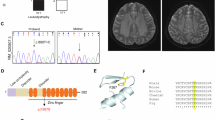Abstract
Leukodystrophies represent a heterogeneous group of rare hereditary diseases affecting the central nervous system. The underlying molecular defect remains unknown in almost 50% of cases. We previously assigned a new locus for leukodystrophy of unknown cause to chromosome 11q14.3 by identifying a de novo microdeletion in a sporadic case. We now report the precise molecular characterization of this microdeletion. Physical mapping of the region of interest allowed us to identify and analyze candidate gene(s) possibly implicated in leukodystrophy.
Similar content being viewed by others
Log in or create a free account to read this content
Gain free access to this article, as well as selected content from this journal and more on nature.com
or
References
Berger J, Moser HW, Forss-Petter S : Leukodystrophies: recent developments in genetics, molecular biology, pathogenesis and treatment. Curr Opin Neurol 2001; 14: 305–312.
Schiffmann R, Boespflug-Tanguy O : An update on the leukodsytrophies. Curr Opin Neurol 2001; 14: 789–794.
Coupry I, Taine L, Goizet C et al: Leukodystrophy and oculocutaneous albinism in a child with an 11q14 deletion. J Med Genet 2001; 38: 35–39.
Jager D, Stockert E, Jager E et al: Serological cloning of a melanocyte rab guanosine 5-prime-triphosphate-binding protein and a chromosome condensation protein from a melanoma complementary DNA library. Cancer Res 2000; 60: 3584–3591.
Toomes C, James J, Wood AJ et al: Loss-of-function mutations in the cathepsin C gene result in periodontal disease and palmoplantar keratosis. Nat Genet 1999; 23: 421–424.
Luyt K, Varadi A, Molnar E : Functional metabotropic glutamate receptors are expressed in oligodendrocyte progenitor cells. J Neurochem 2003; 84: 1452–1464.
Zhang J, Qin S, Sait SN et al: The pericentromeric region of human chromosome 11: evidence for a chromosome-specific duplication. Cytogenet Cell Genet 2001; 94: 137–141.
Hart PS, Zhang Y, Firatli E et al: Identification of cathepsin C mutations in ethnically diverse Papillon–Lefèvre syndrome patients. J Med Genet 2000; 37: 927–932.
Kleinjan DJ, Van Heyningen V : Position effect in human genetic disease. Hum Mol Genet 1998; 7: 1611–1618.
Acknowledgements
This work was supported by a grant of ELA (European Leukodystrophy Association) and ARMA (Association pour la Recherche Médicale en Aquitaine).
Author information
Authors and Affiliations
Corresponding author
Additional information
Electronic databasesUDB: http://bioinformatics.weizmann.ac.il/udb;GDB: www.gdb.org; Advanced BLAST: http://www.ncbi.nlm.nih.gov/BLAST;BLAST 2 Sequences: http://www.ncbi.nlm.nih.gov/gorf/bl2.html;NCBI Map Viewer: http://www.ncbi.nlm.nih.gov/mapview/map_search.cgi;RepeatMasker server: http://woody.embl-heidelberg.de/repeatmask/
Rights and permissions
About this article
Cite this article
Goizet, C., Coupry, I., Rooryck, C. et al. Molecular characterization of an 11q14.3 microdeletion associated with leukodystrophy. Eur J Hum Genet 12, 245–250 (2004). https://doi.org/10.1038/sj.ejhg.5201128
Received:
Revised:
Accepted:
Published:
Issue date:
DOI: https://doi.org/10.1038/sj.ejhg.5201128
Keywords
This article is cited by
-
Detection of an Intragenic Deletion Expands the Spectrum of CTSC Mutations in Papillon–Lefèvre Syndrome
Journal of Investigative Dermatology (2008)
-
Spectrum of CREBBP gene dosage anomalies in Rubinstein–Taybi Syndrome patients
European Journal of Human Genetics (2007)



